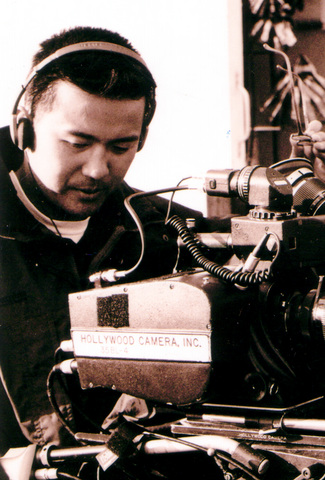In a question-and-answer session at the Sundance Film Festival in 2002 held after the screening of Better Luck Tomorrow, a film about four Asian-American honors high-school students who get themselves involved in test scams, drug dealing, armed theft and finally murder, a vexed audience member stood up and complained that the film didn't give a positive portrayal of Asian-Americans. Respected film critic Roger Ebert loudly rebuked the complainer by saying such a comment would never be made about a movie featuring Caucasians. The stir instantly put the US$250,000-budget film and its creator Justin Lin under the spotlight.
Fast-forward four years. The Taiwan-born filmmaker directed the eight-figure budget The Fast and Furious: Tokyo Drift, which is currently on general release.
On his way to Japan to promote his latest film, Lin visited Taipei last weekend for the screening of A Better Tomorrow: Filmmakers to Watch Film Festival (亞洲奇蹟影展) in Xinmending (西門町). Greeting eye-blinding camera flashes with a constant smiles, Lin said: “It feels good to see the theater play Better Luck Tomorrow and The Fast and Furious: Tokyo Drift at the same time. It makes me see my personal growth as a filmmaker … . I'm living my dream now.”

PHOTO COURTESY OF SERENITY ENTERTAINMENT INTERNATIONAL
Indeed, Lin has come a long way from being an anonymous young director in massive debt after maxing out ten credit cards to make the feature Better Luck Tomorrow, the first independent Asian-American film to be picked up for distribution in the US and which made US$3.8 million at the box office.
Moving to Buena Park, California with his family at the age of nine, Lin grew up as a rebellious teenager who refused to be labeled as a silent Asian-American by joining sports team and the scouts. “I am very American, but always feel like an outsider at the same time,” Lin said.
So it came as no surprise when the UCLA film school graduate addressed stereotypes, labels and identity issues in his breakthrough film. What is striking about the movie is that the characters don't explicitly state who they are and where they come from, but are real people who challenge assumptions with their human complexities.
The film represents the three-dimensional characters struggles within the power geometry of the wider societal structure.
Lin is fascinated with identity, be it ethnical, personal or class-based.
Coming from a blue-collar family that ran a fish-and-chip shop in a mall, Lin was initially draw to his first big-budget, Hollywood production Annapolis on a personal level. Even though he lived close to Los Angeles, Hollywood seemed like a world away to Lin, who related to the film's lead character Jake (played by James Franco), a young man from the wrong side of the tracks who fulfills his dream of attending the US Naval Academy. “In the US, we seldom talk about class because we are so preoccupied with race,” the 34-year-old director said.
Lin secured access to Hollywood studio corridors when offers landed on his desk following the Sundance Film Festival, and subsequently honed a reputation as a director that stands up for what he believes in.
“I initially turned down the offer to direct The Fast and the Furious: Tokyo Drift because I found the script offensive and stereotypical as an Asian-American. But the studio people wanted me back and gave me freedom to revise the story,” Lin said.
So the original set, replete with kimonos and Buddhas, was turned into a more realistic post-modern Tokyo, and the character of Han, the mentor to the main character played by Lucas Black, was created specially for Sung Kang, who played the working-class high-schooler in Better Luck Tomorrow.
“The Asian-American actors I have worked with are talented people but never have any opportunity in the business. Now we are in power, we should create opportunities [for] ourselves,” Lin said, “as a director, you have to have the courage to say no to the studio and to fight for them [the actors].”
Part of Lin's mission is to broaden the range of roles that Asian-American actors play, which are now generally confined to kung fu fighters or slapstick nerds.
When asked how he felt about being hailed as the next Ang Lee (李安) by Entertainment Weekly, Lin said he is following his own path and tries to keep a fine balance between Hollywood and independent filmmaking.
“It's fun making big-budget movies … . The whole budget of Better Luck Tomorrow can't even cover the cost of one-day of shooting for The Fast and the Furious,” Lin said.
Out of the approximately 2,000 indie films made each year, only 16 screened at the Sundance Festival and four or five get distributed. Lin is indeed an overachiever who is just beginning enjoying his success in Hollywood. Nevertheless, the fast-rising director still remains true to his indie roots and frequently returns to independent filmmaking.
Five years of experience in mainstream cinema has shown the director that filmmaking is all about business. In the eyes of Lin, ethnicity is not an issue in Hollywood, but money is. The studios don't make a film with an all Asian-American cast simply because it can't make a profit.
“Everything I make is Asian-American because it is seen through my eyes,” Lin said. “Hollywood isn't racist and they don't go like ‘we should make films about African-Americans.’ They make those films because market research shows African-Americans want to see films about themselves. But the spending pattern of Asian-Americans, most of who belong to the middle-class, is shown to be the same as the white people. When Asian-Americans go to theaters, they just want to see Hollywood superstars.”
Better Luck Tomorrow can be seen at the touring film festival from tomorrow through Sept. 8 at Taichung Wonderful Cinema (台中萬代福影城) and Kaohsiung Oscar Theater (高雄奧斯卡戲院) from Sept. 15 to Sept. 22. For more information, visit blog.yam.com/serenity_movie.

June 2 to June 8 Taiwan’s woodcutters believe that if they see even one speck of red in their cooked rice, no matter how small, an accident is going to happen. Peng Chin-tian (彭錦田) swears that this has proven to be true at every stop during his decades-long career in the logging industry. Along with mining, timber harvesting was once considered the most dangerous profession in Taiwan. Not only were mishaps common during all stages of processing, it was difficult to transport the injured to get medical treatment. Many died during the arduous journey. Peng recounts some of his accidents in

“Why does Taiwan identity decline?”a group of researchers lead by University of Nevada political scientist Austin Wang (王宏恩) asked in a recent paper. After all, it is not difficult to explain the rise in Taiwanese identity after the early 1990s. But no model predicted its decline during the 2016-2018 period, they say. After testing various alternative explanations, Wang et al argue that the fall-off in Taiwanese identity during that period is related to voter hedging based on the performance of the Democratic Progressive Party (DPP). Since the DPP is perceived as the guardian of Taiwan identity, when it performs well,

A short walk beneath the dense Amazon canopy, the forest abruptly opens up. Fallen logs are rotting, the trees grow sparser and the temperature rises in places sunlight hits the ground. This is what 24 years of severe drought looks like in the world’s largest rainforest. But this patch of degraded forest, about the size of a soccer field, is a scientific experiment. Launched in 2000 by Brazilian and British scientists, Esecaflor — short for “Forest Drought Study Project” in Portuguese — set out to simulate a future in which the changing climate could deplete the Amazon of rainfall. It is

Artifacts found at archeological sites in France and Spain along the Bay of Biscay shoreline show that humans have been crafting tools from whale bones since more than 20,000 years ago, illustrating anew the resourcefulness of prehistoric people. The tools, primarily hunting implements such as projectile points, were fashioned from the bones of at least five species of large whales, the researchers said. Bones from sperm whales were the most abundant, followed by fin whales, gray whales, right or bowhead whales — two species indistinguishable with the analytical method used in the study — and blue whales. With seafaring capabilities by humans